The Multifaceted World of Crystals and Stones
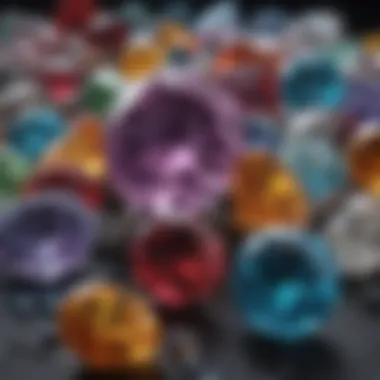
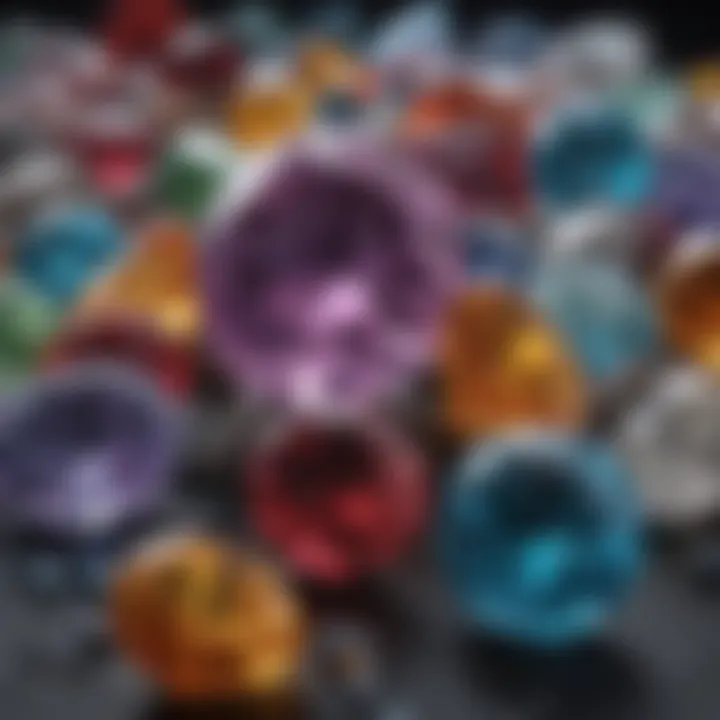
Intro
Crystals and stones have captivated human interest for millennia, their allure stretching from ancient practices to modern-day use. This fascination isn't simply about beauty; it's also about the stories they tell, the geological origins they represent, and the myriad roles they assume in our lives. From collectors displaying sparkling additions in their homes to jewelry designers crafting exquisite pieces, the demand for these natural wonders is as varied as the stones themselves.
While some seek these gems for their visual aesthetics, others believe in their metaphysical properties, claiming they resonate energies that can influence mood and well-being. Whether it's amethyst for tranquility or citrine for abundance, the belief in their power remains prevalent across cultures.
As we embark on this exploration, we aim to peel back the layers of both the physical properties and the cultural significance infused in these precious commodities. The journey will whisk you through a captivating landscape of shimmering stones and their place in human history, between scientific principles and artistic appreciation.
Gemstone Overview
Definition and Characteristics
At the core of our exploration lies the definition of gemstones. Simply put, gemstones are naturally occurring minerals that, through cutting and polishing, are transformed into objects of beauty—think rings, necklaces, and bracelets. Each gemstone showcases distinct characteristics such as color, clarity, and hardness. In the realm of geology, these attributes stem from the mineral's atomic structure and formation processes.
For instance, diamonds, with their unrivaled hardness, are often rated using the Mohs scale, which measures a material's resistance to scratching. Other stones, like emeralds or rubies, are valued not only for their stunning hues but also for their relative rarity, leading to their elevated status in both market and culture.
Classification of Gemstones
Gemstones can be classified into two primary categories: precious and semi-precious. Precious stones—diamonds, rubies, sapphires, and emeralds—are distinguished by their rarity and significance in jewelry-making.
On the other hand, semi-precious stones encompass a vast array, including garnet, amethyst, and opal. Although the term 'semi-precious' can be somewhat misleading, as many of these stones possess unique beauty and value proportionate to their rarity.
"The beauty of a gemstone lies not just in its sparkle, but in its journey from deep within the earth to the hands of those who treasure them."
Historical Significance
Ancient Uses and Cultural Importance
The historical tale of gemstones is rich and diverse, intertwining with the evolution of cultures around the globe. In ancient Egypt, lapis lazuli was treasured not merely for its deep blue color but also for its belief to provide protection in the afterlife. Likewise, in India, gemstones were often embedded in royal jewelry, believed to bestow wealth and prosperity upon the wearer.
In many ancient cultures, stones were not to be merely worn; they played significant roles in rituals, symbolizing deities and serving as talismans. Jade, for example, has been revered in Chinese culture for centuries, associated with purity, wisdom, and protection. Across time, the belief that gemstones hold powers has lulled civilizations into attributing great emotional and social weight to these earthly treasures.
Myths and Legends Surrounding Gemstones
Alongside their historical uses, gemstones come wrapped in myths and legends that add to their mystery. Take, for instance, the tale of the Hope Diamond, said to bring misfortune to its owner. Despite its attached curses, it remains one of the world’s most sought-after gems, underscoring how myths can enhance allure.
Another well-known legend involves the belief that wearing an amethyst can protect against drunkenness, with roots tracing back to ancient Greek culture, where the term itself signifies "not intoxicated."
As we dissect the multifaceted nature of crystals and stones, it becomes clear that their significance transcends mere aesthetics. Their history is a tapestry rich with tales, beliefs, and scientific inquiry, painting a picture of our enduring fascination with these natural marvels.
Intro to Crystals and Stones
The exploration of crystals and stones opens a window to a captivating world where geology meets art, spirituality, and history. These natural formations reveal stories embedded deep in the Earth's crust, showcasing the astonishing processes that have occurred over millennia. Each crystal and stone carries its own fingerprint, suffused with a unique blend of minerals, energy, and beauty. This article aims to peel back the layers, unveiling the multifaceted roles these fascinating entities play in our lives, from decor and jewelry to healing practices and cultural ceremonies.
When we delve into the realm of crystals and stones, it's essential to recognize their significance beyond sheer aesthetics. The importance of understanding these geological wonders lies in their potential to connect us with the Earth, encourage mindfulness, and stimulate creativity. People from various walks of life, including gemstone enthusiasts, collectors, and jewelry designers, can benefit immensely from this knowledge, enhancing not just individual appreciation but also the intricate art of crafting with stones.
Crystals and stones have transcended their earthly origins to become symbols of personal and spiritual growth. The multifaceted characteristics of each formation offer insights into their healing properties and metaphysical alignments, which many believe can influence one’s emotional, physical, and spiritual well-being. Grasping their definitions and historical backgrounds sets the stage for an even richer understanding.
"Crystals are not just pretty; they represent the very essence of our connection to the universe."
As we progress, the narrative will cover:
- Defining Crystals and Stones: We will clarify what constitutes a crystal versus a stone, exploring their fundamental characteristics and distinctions.
- Historical Perspectives: This segment offers a glimpse into how different cultures have revered crystals and stones, establishing them as essential components in various societies, from ancient civilizations to modern spirituality.
It’s through these discussions that we hope to create a deeper appreciation for the natural world, one that transcends mere fascination and enters into the realm of meaningful interaction and understanding with these beautiful formations.
Geological Formation
Understanding the geological formation of crystals and stones is foundational to appreciating their characteristics and applications. Without this lens, one would only skim the surface, missing the story buried within the earth that shaped these remarkable materials. Geology, at its core, provides insight into the life cycle of stones, revealing the natural forces, environments, and timelines involved in their creation. This knowledge not only heightens appreciation but also informs collectors, jewelers, and even healers in their respective pursuits.
Mineral Composition
Mineral composition serves as the bedrock of a crystal’s identity. Different stones are made up of various minerals, which dictate their appearance and behavior. For instance, the deep red hue of garnet draws from iron and aluminum, while the unique translucence of quartz is due to its silicon dioxide makeup.
Crystals can be classified into two broad groups: metallic and non-metallic.
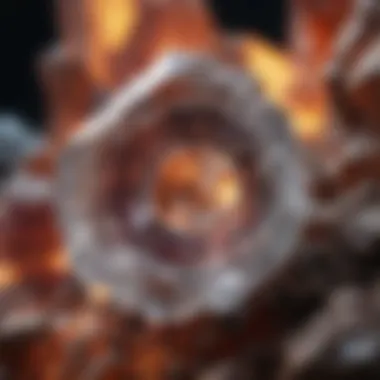
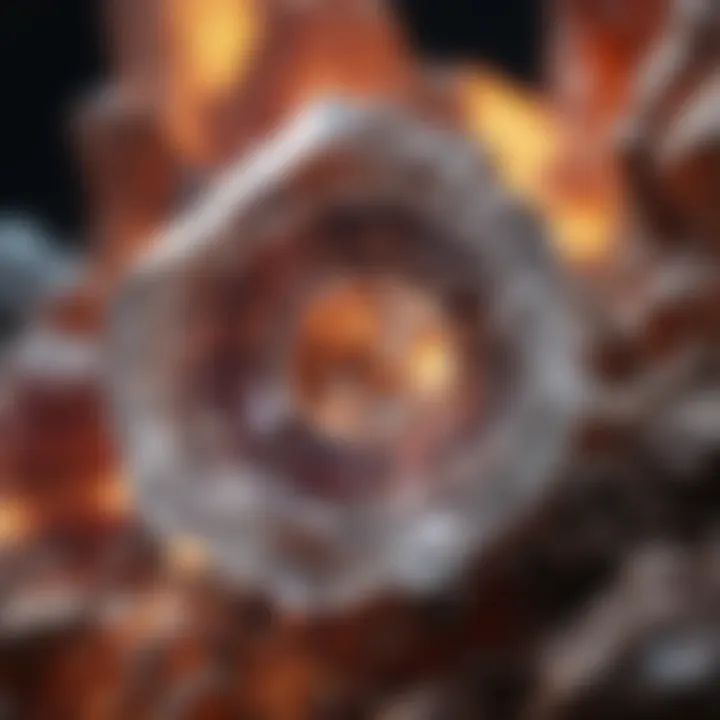
- Metallic minerals lend themselves to distinct colors and properties, usually possessing a shiny luster.
- Non-metallic minerals, in contrast, often showcase a matte finish with a wide array of colors, making them visually captivating yet more prone to environmental wear.
This distinction highlights why some stones find their way into industrial applications while others shine in the realm of aesthetics. By understanding which minerals comprise a stone, one can predict its durability, rarity, and market value.
Crystal Growth Processes
The processes that lead to crystal growth can be likened to a natural ballet, where environmental conditions play the lead roles. Crystallization occurs when molten material cools, allowing minerals to arrange themselves into structured patterns. This process takes time, often resulting in the stunning forms we admire today.
There are various methods by which crystals can grow, including:
- Igneous formation: When magma cools, forming crystals underground, resulting in gems such as diamond or amethyst.
- Metamorphic processes: High pressure and temperature lead to other formations, giving birth to stones like jadeite or garnet.
- Sedimentary crystallization: Through evaporation and precipitation, crystals can form in sedimentary environments, such as halite or calcite.
Each method not only affects the physical structure but also influences metaphysical attributes often ascribed to the stones. Embracing these processes opens up a greater awareness of the significance of a stone beyond mere aesthetics.
Types of Gemstones
The world of gemstones is vast, and its exploration reveals a fascinating palette of colors, shapes, and textures. Gemstones fall into several categories:
- Precious Stones: Commonly recognized for their rarity and value, these include diamonds, emeralds, rubies, and sapphires.
- Semi-Precious Stones: While not as rare, they hold beauty and charm, such as aquamarine, garnet, and amethyst.
- Organic Gemstones: Uniquely fashioned from living organisms, consider pearls, coral, or amber.
Each type brings its own piece of geological history and intrinsic value to the conversation. Whether one seeks them for adornment, healing, or investment, recognizing the types enables a deeper understanding of what resonates with an individual.
"The beauty of a gemstone lies not solely in its physical attributes, but also in the tales it tells of the earth’s ancient past."
Thus, the geological formation becomes not merely an academic inquiry but a journey into the heart of Earth itself, beckoning enthusiasts and collectors alike to appreciate their surroundings on a profoundly deeper level.
Classification of Crystals and Stones
Understanding the classification of crystals and stones plays a pivotal role in appreciating their beauty and value. This section not only lays the groundwork for identifying different types of crystals but also enhances comprehension regarding their applications in daily life and culture. The distinction among natural and synthetic stones, the categorization into precious and semi-precious, and the aspects of color and clarity equip gemstone enthusiasts, collectors, and designers with the necessary knowledge to make informed decisions. Furthermore, this classification informs potential buyers about the qualities and authenticity of stones, which is crucial in both purchasing and collecting.
Natural vs. Synthetic
The debate between natural and synthetic crystals often raises eyebrows, especially among collectors. Natural crystals are those forged by nature over millions of years, embodying qualities that are unique to their geological origins. Conversely, synthetic stones are lab-created alternatives that replicate the qualities of their natural counterparts.
One of the significant benefits of knowing this difference is understanding value. Natural gemstones typically command a higher price due to their rarity and the complex processes they undergo for formation. For example, a natural diamond holds a distinct allure, often representing significant emotional value.
However, synthetic stones shouldn’t be dismissed outright. They offer affordability and access to stunning designs that might not be possible with limited natural stones. For example, cubic zirconia, a synthetic alternative to diamonds, has gained popularity in fashion jewelry due to its brilliance and price point.
Precious vs. Semi-Precious
Traditionally, gems are classified as precious or semi-precious. The term “precious” primarily encompasses diamonds, rubies, sapphires, and emeralds. These stones are often sought after due to their historical significance and high market demand.
On the other hand, semi-precious stones, such as amethyst, garnet, and aquamarine, possess their own unique appeal without reaching the sky-high prices of precious gems. While they are less exclusive, their diverse range enhances the creative potential for jewelry designers, allowing them to craft pieces that resonate with broader audiences. Many collectors find joy in exploring the vibrant plethora of semi-precious options available, unlocking a gem of a find among lesser-known stones.
"One person’s semi-precious is another’s treasure." People’s tastes vary greatly, and what may appear less valuable at first glance might captivate someone deeply.
Color and Clarity
When assessing crystals and stones, color and clarity remain predominant characteristics that influence their classification. Color is perhaps the most recognizable feature; the richness and saturation often dictate desirability and worth. For instance, a deep blue sapphire is generally more prized than a lighter hue, thereby affecting its market value.
Clarity, on the other hand, refers to how free a gemstone is from inclusions and blemishes. A stone with few impurities is more desirable, as it often indicates a higher natural quality. When it comes to diamonds, the absence of color and imperfections is particularly significant, emphasizing the well-known "Four Cs": Cut, Color, Clarity, and Carat.
Metaphysical Properties
When one peers into the realm of crystals and stones, it becomes apparent that their significance extends beyond their geological composition. The metaphysical properties, in particular, shine a spotlight on their purported effects on the human spirit and mind. Crystals and stones are often regarded as vessels of energy, bringing forth profound insights and enhancements to both emotional and physical well-being. This section delves into each aspect of these metaphysical properties to unravel their intriguing nature and connection to our lives.
Healing Properties
The belief in the healing properties of crystals is not just a fad; it has roots in ancient traditions. Many cultures have long held that specific crystals harbor unique energies capable of fostering healing. For example, amethyst, in many circles, is thought to aid in spiritual growth and mitigate stress, allowing the individual to find a sense of calm amid the chaos of daily life.
Each crystal is often associated with different chakras, influencing physical ailments or emotional states:
- Rose Quartz: Known for its relationship with love, it is said to open the heart chakra and promote feelings of compassion and peace.
- Lapis Lazuli: This deep blue stone is often linked to the throat chakra, believed to enhance communication and self-expression.
- Citrine: Associated with the solar plexus chakra, it is said to empower one’s personal will and creativity, helping to manifest abundance.
Though the scientific community remains skeptical, many individuals claim to experience tangible benefits, noting how these stones serve as comforting reminders of their intentions and aspirations.


Energy and Vibrational Frequencies
The energy of crystals is often likened to a symphony, where each type resonates at a different frequency. This idea springs from the principle that everything in the universe, including human beings, emits a vibrational frequency. Crystals amplify, absorb, or reflect these energies, acting as either a booster or a stabilizer for one’s own vibrations.
For instance, clear quartz is considered a powerful energy amplifier, utilized in various practices to enhance the effect of other stones. Individuals seeking to elevate their state of balance may carry or meditate with certain crystals to align with their individual vibrational frequency.
In a world where stress is part and parcel of existence, many are drawn to this concept, believing that exposure to specific stone energies can facilitate a shift towards a more harmonious and balanced daily life.
"Crystals are tools that resonate with the vibrational energies of the universe, helping us tune into the best versions of ourselves."
Symbolic Representations
The symbolic significance of crystals can’t be overlooked either. Many gemstones have been ascribed meanings based on their colors, shapes, and historical contexts.
- Turquoise: Has long been seen as a protective stone, often associated with safety during travels.
- Obsidian: Known for grounding properties, it is often related to purification, thought to shield against negativity.
- Sapphire: Historically symbolizes wisdom, often worn by those in positions of authority.
These representations form a bridge between humanity and the earth's energies, allowing individuals to seek deeper connections with their surroundings and themselves. Assembling a collection of stones often reflects personal journeys, aspirations, or even the challenges one overcomes.
Practical Applications
Understanding the practical applications of crystals and stones reveals their significance far beyond aesthetics or metaphysical beliefs. These natural wonders serve myriad purposes in our daily lives. From enhancing personal style to contributing to innovative industry solutions, crystals and stones are intertwined with various aspects of both creativity and functionality. Their importance spans cultural heritage, economic value, and personal wellness, grounded in deep historical roots and contemporary needs.
Jewelry Making
Jewelry making stands as one of the most celebrated applications of crystals and stones, demonstrating not only artistic prowess but also a profound connection to personal expression. Artisans utilize a variety of gemstones, each reflecting its unique properties and allure. For example, the unmistakable sparkle of diamonds can convey luxury and exclusivity, while the calming tones of amethyst can reveal a subtler elegance.
When incorporating these stones into jewelry, designers often consider sourcing ethically mined materials. As consumers grow more aware of their purchasing decisions, there’s a movement towards more sustainable practices. This shift includes the popularity of lab-grown stones, which offer an eco-friendly alternative without sacrificing quality. Ultimately, proper gemstone selection enhances any piece’s emotional and aesthetic value, allowing wearers to showcase their individuality.
Interior Design
In the realm of interior design, crystals and stones furnish more than just beauty—they imbue spaces with significant energy and character. Architects and designers often embrace natural stones like granite, marble, and quartz for countertops, walls, and flooring, promoting durability and style. With endless colors and patterns, these materials contribute texture and warmth to both modern and traditional environments.
Additionally, decorative crystals such as selenite or clear quartz are increasingly utilized in home decor, notably as statement pieces. These elements not only catch the eye but also satisfy the growing intrigue surrounding energy efficiency and calming aesthetics in interior spaces. Homeowners are finding that integrating stones in design doesn’t merely elevate a room’s visual appeal; it can foster a harmonious atmosphere and encourage positive energy flow.
Industrial Uses
The industrial sector relies heavily on the functionality of crystals and stones, extending their use far beyond decorative applications. Quartz, for example, is widely utilized in electronics due to its piezoelectric properties. These qualities mean that quartz can convert mechanical energy into electrical energy, making it a critical component in watches, phones, and circuit boards.
Furthermore, various minerals are indispensable in manufacturing processes. Talc is used in cosmetics, while limestone is essential in concrete production. Understanding these applications not only illustrates the versatility of crystals and stones but also highlights their role in nurturing numerous industries essential to modern living.
The value of crystals and stones isn't only in their beauty; it's also rooted in their practical benefits across many sectors, from art to technology.
Recognizing these applications encourages a greater appreciation for crystals and stones, fostering a connection that transcends their surface-level allure. Through practical uses, these geological treasures maintain a vital status in both everyday life and industry.
Cultural Significance
Understanding the cultural significance of crystals and stones offers a profound insight into how societies across the globe interpret these natural wonders. Throughout history, different cultures have imbued these minerals with meaning, often attributing them not just aesthetic value, but significant spiritual and societal importance. This section emphasizes how these tangible elements bridge the gap between human experience and nature, facilitating rituals, traditions, and personal beliefs that shape cultural identity.
Folklore and Mythology
Crystals and stones have played a crucial role in folklore and mythology, often seen as gifts from gods or the Earth itself. Ancient civilizations like the Egyptians believed that lapis lazuli represented the heavens and was a protector of the soul in the afterlife. Similarly, in Celtic traditions, stones such as quartz were viewed as a source of wisdom, with many legends suggesting their mystical properties could heal or provide guidance.
These tales often carried deeper meanings, shaping community beliefs around protection and prosperity. The widespread belief that certain stones bring luck is still prevalent today, with people clinging to the charm of amethyst for peace or citrine for manifestation. It's not just about the mineral itself; it's about what these stories say about us and how we find solace within the natural world.
Religious Practices
In various religious contexts, stones maintain a place of reverence and ritual. For instance, in Hinduism, crystals like clear quartz and rose quartz play vital roles in meditation and healing practices. They are often used in altar layouts, reflecting light and energy, enhancing spiritual connections during prayers. This practice exemplifies how the sacredness of stones can amplify ritualistic atmosphere, providing a tangible representation of faith.
Moreover, in Christianity, gemstones are mentioned in biblical texts, often tied to divine symbolism. The twelve stones in the breastplate of Aaron highlight their importance in religious ceremonies, believed to signify the twelve tribes of Israel and to carry messages from the divine. These elements are not mere decoration; they are perceived as conduits of spiritual energy, binding communities through shared beliefs.
Modern Spiritualism
Modern spiritualism has also embraced the aesthetic and metaphysical properties of stones, as crystals are seen as tools for personal growth and self-discovery. Practitioners utilize these elements to align energies, set intentions, and bring about transformation in their lives. The popularity of crystal healing is a testament to their ongoing cultural relevance, merging ancient practices with contemporary needs.
People often engage in practices such as "crystal grids," where multiple stones are arranged with the intention to amplify their combined energies. From meditation circles to wellness retreats, stones are firmly rooted in the contemporary spiritual landscape, fostering both personal and communal connections.
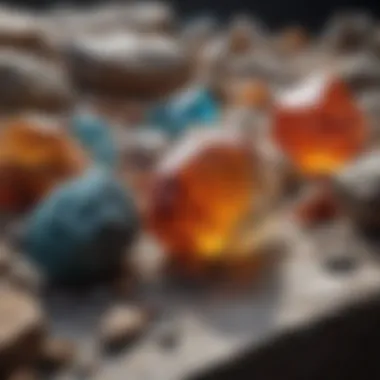
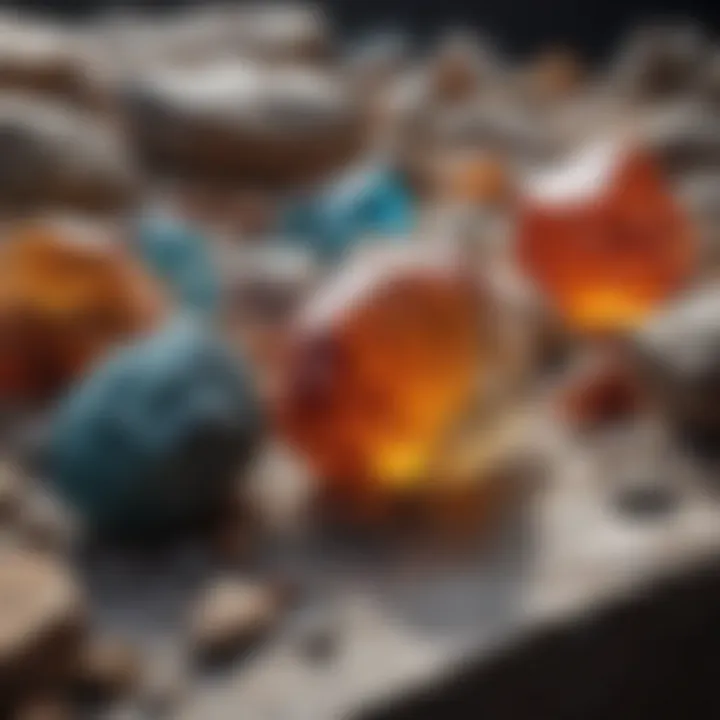
As communities evolve, the interpretation and usage of crystals and stones continue to shift, yet their cultural significance remains steadfast. They serve not just as adornments, but as symbols of hope, faith, and the intricate relationship humans maintain with the earth.
"In the tapestry of human experience, crystals and stones are threads that weave together history, belief, and identity."
Through stories, practices, and rituals, they remind us of our place in the world, echoing the past while illuminating paths to the future.
Market Trends
Understanding market trends in the realm of crystals and stones is essential for enthusiasts, collectors, and businesses alike. This section dives into key areas, such as investment value and emerging markets, shedding light on the dynamics driving interest and potential financial gain. The movement of this market reflects broader economic shifts, consumer behaviors, and even the ebb and flow of cultural significance, which makes it an intriguing subject to explore.
Investment Value
In recent years, the investment potential of gemstones has garnered considerable attention. The allure of certain crystals is not just in their aesthetic value; they represent a tangible asset that can appreciate over time.
- Rarity plays a crucial role; rare stones like diamonds, rubies, and emeralds often fetch astronomical prices at auctions. Investors often select these high-value stones with the hope of reaping profit in the long run.
- The trend towards investing in alternative assets, such as colored diamonds or unique minerals, signifies a growing interest. Individuals are now viewing these stones not just as adornments but as long-term investment strategies.
- Market reports suggest that the value of some specific gemstones can rise significantly due to supply chain constraints or global economic changes, making it essential for buyers to stay updated on market shifts.
Moreover, the introduction of platforms for trading gemstones online has further democratized this market. New investors can easily buy, sell, and trade stones, which contributes to a more vibrant, accessible marketplace.
Emerging Markets
As the global interest in wellness and holistic practices grows, so too do the markets for crystals and stones, especially in developing regions. Countries like India, Brazil, and Madagascar are gaining recognition as emerging markets in the gemstone industry.
- Cultural significance drives demand. As these regions incorporate crystals into traditional medicine and holistic practices, the appeal of their products increases not just locally but across the globe.
- Sustainable sourcing is becoming a crucial issue for consumers. Support for ethically mined stones and materials is pushing market growth, nudging providers to adapt to these values.
- The rise of e-commerce has created new avenues for local artisans in these countries to market their stones to a worldwide audience, expanding their reach beyond traditional borders.
"The demand for crystals and stones continues to rise globally, shifting the market dynamics and offering unique investment avenues."
Understanding these market trends allows collectors and investors to make informed decisions and better navigate the colorful, yet complex world of crystals and stones. As we continue into an era increasingly interested in sustainability and spirituality, the future looks bright for this industry, opening doors to countless opportunities.
Care and Maintenance
Caring for and maintaining crystals and stones is every bit as crucial as understanding their origin or role in history. They are not simply decorative items; these natural wonders can possess striking visual appeal and unique metaphysical properties that enhance well-being. However, without proper care, these characteristics can fade or diminish over time. This section provides insight into effective practices that can help preserve the integrity and vitality of your crystals and stones, ensuring they remain vibrant parts of your collection.
Cleaning Techniques
One might think that cleaning stones is a straightforward endeavor, akin to wiping dust from shelves. However, the method chosen depends on the specific types of crystals and their chemical compositions. Some stones can stand up to water like a champ, while others are more delicate and could dissolve or scratch. Here are a few effective techniques both beginner and seasoned collectors can use:
- Water Swish: For resilient stones such as quartz or amethyst, rinsing under lukewarm running water can help remove accumulated dirt. Ensure to pat dry with a soft cloth to prevent water spots.
- Salt Method: Salt can be a natural cleansing agent. Mixing salt with water, soak tougher stones like smoky quartz for a few hours, then rinse. But be careful! Avoid this with softer stones like selenite, which could effortlessly dissolve.
- Sound Cleansing: Use a quartz singing bowl or tuning forks. The vibrations can clear negative energy without introducing any physical stress to the stones.
- Sun or Moon Light: Depending on the individual properties, exposing some crystals to sunlight can recharge them, but others like amethyst may fade under harsh light. Moonlight, especially during the full moon, is generally gentle and safe for most stones.
"Proper cleaning techniques ensure that the energies of crystals remain clear and vibrant, allowing for optimal effectiveness."
Storage Solutions
Storing your crystals and stones is just as important as cleaning them. Mishandling or improper storage can lead to chips, scratches, or even complete breakage. Here are a few effective strategies:
- Soft Pouches: Consider using soft fabric pouches made from velvet or cotton. These provide cushioning and prevent stones from sticking together or bumping against harder surfaces.
- Dedicated Storage Boxes: Invest in a box specifically designed for stones, preferably one with compartments. This keeps different types of stones separate, thereby avoiding scratches. Look for boxes with velvet linings for added protection.
- Displays: If you’re inclined to show off your collection, ensure you place heavier stones at the bottom of your display and lighter ones above. This not only looks aesthetically pleasing but also reduces the risk of toppling or damaging your crystals.
- Avoid Extreme Conditions: Keep your collection away from direct sunlight and extreme temperatures, as these can alter the chemical stability of many stones. A cool, dry place usually suits best.
With the right cleaning techniques and storage solutions in place, your crystals and stones will not only thrive but also continue to bring joy, energy, and inspiration into your life.
The Future of Crystals and Stones
In an era where sustainability and technological progress shape almost every aspect of our lives, the future of crystals and stones is no exception. This section aims to shed light on how these age-old treasures can evolve in tandem with modern practices and innovations. Understanding the future of these natural marvels is crucial, not only for enthusiasts and collectors but also for the industries that utilize them—from jewelry design to metaphysical applications. With increasing scrutiny over environmental impacts, our approach to sourcing and utilizing crystals must innovate. Additionally, as technological advancements continue to unfold, they bring unique opportunities and considerations for the field.
Sustainable Practices
Sustainability isn't just a buzzword; it’s becoming a game-changer in the world of crystals and stones. The extraction of these materials has often led to environmental degradation, and as a result, there’s a growing call for more responsible practices. Sustainable harvesting of crystals focuses on methods that minimize ecological impact. For instance:
- Responsible Sourcing: Prioritizing suppliers and mines that adhere to ethical standards can make a real difference. It means opting for sourced stones that either come from responsibly managed mines or are lab-created, reducing harm done to the Earth.
- Recycling Crystals: Some companies are recycling broken crystals or stones into different forms. Think of it like turning scrap metal into new creations—this reduces waste and gives old stones new life.
- Community Involvement: Engaging with local communities can create a symbiotic relationship. Supporting local miners and artisans not only helps their economies but also encourages a culture of respect for the land.
Sustainable practices aren’t just beneficial for the environment; they resonate with consumers who are increasingly conscious of their purchases. This clout can shift market dynamics significantly.
Technological Innovations
Technological advancements are pushing the boundaries of what is possible with crystals and stones. From more efficient mining techniques to the rise of lab-created gems and stones, the landscape is changing. Here are some noteworthy innovations:
- Synthetic Gems: Thanks to advances in technology, companies can now create synthetic versions of popular stones like diamonds, rubies, and sapphires that often rival their natural counterparts in beauty and durability. These are not just tools to cut costs; they offer an ethical alternative that lessen the demand for mined stones, preserving natural ecosystems.
- 3D Printing: The 3D printing tech is making waves in the jewelry industry. Designers can create intricate pieces that would be nearly impossible to produce by traditional means. Moreover, innovative materials can substitute for some aspects of natural stones, leading to unique, stunning designs.
- Data Analytics in Sourcing: With big data analysis, certain companies can better predict market trends and preferences for different crystals, allowing for a more efficient supply chain that meets consumer demands without overexploiting natural deposits.
The world of crystals and stones is on the cusp of a transformation, where sustainability and technology are likely to become its new bedrock. Staying ahead of these trends not only allows enthusiasts and collectors to align themselves with broader movements but also contributes to a more sustainable and innovative future.
"As we approach the future, the integration of sustainable practices with technological advancements could redefine our relationship with crystals and stones."
The ongoing evolution of crystals and stones speaks to not just their physical beauty but also their emerging role in our commitment to a sustainable and innovative future.







